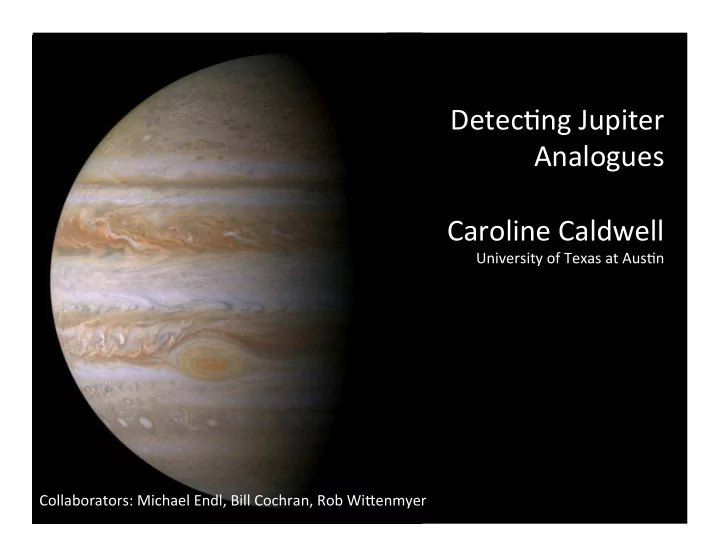

¡ ¡ ¡ ¡ Detec&ng ¡Jupiter ¡ ¡ ¡ Analogues ¡ ¡ ¡ ¡ ¡ Caroline ¡Caldwell ¡ ¡ ¡ University ¡of ¡Texas ¡at ¡Aus&n ¡ ¡ ¡ ¡ ¡ ¡ ¡ ¡ ¡ ¡ ¡ ¡ ¡ ¡ Collaborators: ¡Michael ¡Endl, ¡Bill ¡Cochran, ¡Rob ¡WiEenmyer ¡ ¡
• Are ¡there ¡other ¡solar ¡systems ¡like ¡ours? ¡– ¡ Solar ¡System ¡structure ¡and ¡evolu&on ¡ • 12 ¡years ¡of ¡observa&ons ¡ • How ¡well ¡can ¡we ¡detect ¡Jupiter ¡analogues? ¡
Sample ¡ All ¡data ¡was ¡collected ¡at ¡the ¡McDonald ¡Observatory ¡2.7m ¡Harlan ¡J. ¡Smith ¡Telescope ¡ using ¡the ¡Tull ¡High ¡Resolu&on ¡Spectrograph ¡from ¡1998 ¡to ¡2011. ¡Our ¡sample ¡consists ¡of ¡ 81 ¡stars ¡that ¡do ¡not ¡have ¡known ¡companions. ¡They ¡have ¡luminosity ¡classifica&ons ¡ near ¡that ¡of ¡our ¡sun ¡(no ¡giant ¡stars), ¡and ¡at ¡least ¡a ¡4330 ¡day ¡(one ¡Jupiter ¡period) ¡ observa&on ¡&me ¡line. ¡Outlying ¡observa&ons ¡and ¡some ¡with ¡significantly ¡high ¡error ¡ have ¡been ¡removed ¡on ¡an ¡individual, ¡star-‑by-‑star ¡basis. ¡Linear ¡or ¡quadra&c ¡trends ¡ produced ¡by ¡binary ¡stars ¡have ¡been ¡removed ¡when ¡necessary. ¡
Radial ¡Velocity ¡ F/F 0 ¡= ¡ c/(c±v S ) ¡ Doppler ¡Shia ¡Equa&on ¡ K ¡ ≡ ¡radial ¡velocity ¡semi-‑amplitude ¡= ¡2π a ¡ sin ¡I ¡ ¡ ¡ ¡ ¡ ¡ ¡ ¡ ¡ ¡ ¡ ¡ ¡ ¡ ¡ ¡ ¡ ¡ ¡ ¡ ¡ ¡ ¡ ¡ ¡ ¡ ¡ ¡ ¡ ¡ ¡ ¡ ¡ ¡ ¡ ¡ ¡ ¡ ¡ ¡ ¡ ¡ ¡ ¡ ¡ ¡ ¡ ¡ ¡ ¡ ¡ ¡ ¡ ¡ ¡ ¡ ¡ ¡ ¡ ¡ ¡ ¡ ¡ ¡P√ ¡( 1− ¡ e 2 ) ¡ Above, ¡the ¡radial ¡velocity ¡of ¡ the ¡Sun ¡from ¡a ¡point ¡co-‑ planar ¡in ¡our ¡solar ¡system. ¡ ¡ ¡ K ¡(Jupiter) ¡= ¡12.4 ¡m/s ¡ P ¡(Jupiter) ¡= ¡12 ¡years ¡ a ¡(Jupiter) ¡= ¡5 ¡A.U. ¡ ¡ The ¡smaller ¡perturba&on ¡in ¡ the ¡signal ¡is ¡caused ¡by ¡Saturn. ¡ ¡
Star ¡+ ¡Iodine ¡= ¡High ¡Precision ¡(a ¡few ¡m/s) ¡Radial ¡Velocity ¡Measurements ¡ ¡ Iodine ¡gas ¡ only ¡ Star ¡only ¡
1. ¡Add ¡a ¡“Jupiter ¡signal” ¡to ¡the ¡data. ¡ ¡ Jupiter ¡Signal= ¡ 4 ¡and ¡5 ¡AU ¡ 1, ¡2, ¡3, ¡and ¡4 ¡M ¡(Jupiter) ¡ 8 ¡Phases ¡ ¡ 2. ¡Detect ¡period ¡of ¡injected ¡signal ¡with ¡periodogram ¡
Injected ¡Keplerian ¡ ¡ Orbit ¡Parameters ¡ 5AU ¡ 4AU ¡ T= ¡4330 ¡ days ¡ T=2930 ¡ v(1M)=12.4 ¡ v(1M)=14.2 ¡ v(2M)=25 ¡ v(2M)=28.4 ¡ v(3M)=37 ¡ v(3M)=42.6 ¡ v(4M)=51 ¡ v(4M)=56.8 ¡
¡ ¡
ý ¡ ¡
ý þ ¡ ¡
Detec&on ¡Limits ¡ • “True” ¡Jupiter ¡detec&on ¡limit ¡is ¡2.5%. ¡ • 4AU, ¡3M ¡limit ¡is ¡75%. ¡ • 5AU ¡limit ¡will ¡be ¡improved ¡by ¡extending ¡the ¡observa&onal ¡&meline. 4AU ¡limit ¡saturated ¡by ¡signal ¡to ¡noise. ¡
4/8 ¡Detec&on ¡ 90 ¡ 80 ¡ 70 ¡ 60 ¡ 50 ¡ 40 ¡ 30 ¡ 20 ¡ 10 ¡ 0 ¡ 5au1m4/8 ¡ 5au2m4/8 ¡ 5au3m4/8 ¡ 5au4m4/8 ¡ 4au1m4/8 ¡ 4au2m4/8 ¡ 4au3m4/8 ¡ 4au4m4/8 ¡ • At ¡the ¡lowest ¡level ¡(5AU,1M) ¡we ¡recover ¡%50 ¡of ¡the ¡phases, ¡%50 ¡percent ¡ of ¡the ¡&me. ¡ • S&ll ¡need ¡to ¡increase ¡the ¡observa&on ¡&me ¡line ¡and ¡improve ¡S/N. ¡
Conclusion: ¡ 1. We ¡detect ¡2.5% ¡of ¡true ¡Jupiters ¡in ¡our ¡ sample ¡of ¡81 ¡stars. ¡It ¡may ¡improve ¡once ¡ more ¡of ¡the ¡signal ¡has ¡been ¡recorded. ¡ ¡ 2. The ¡recovery ¡rate ¡increases ¡un&l ¡it ¡ reaches ¡4AU ¡3M, ¡where ¡it ¡becomes ¡ saturated ¡indica&ng ¡a ¡signal ¡to ¡noise ¡ problem. ¡ ¡ ¡ Future: ¡ 1. Con&nue ¡observing ¡to ¡add ¡more ¡stars ¡to ¡ sample, ¡and ¡improve ¡detec&on ¡of ¡lower ¡ signal ¡long ¡period ¡candidates. ¡ 2. Try ¡to ¡improve ¡signal ¡to ¡noise ¡of ¡new ¡data ¡ points. ¡ 3. Experiment ¡with ¡other ¡methods ¡of ¡ detec&ng ¡periods ¡and ¡compare ¡results. ¡ ¡ The ¡End. ¡
Recommend
More recommend